Beth Kephart's Blog, page 141
February 27, 2013
write the journey: a memoir exercise (and a passage from El Salvador)
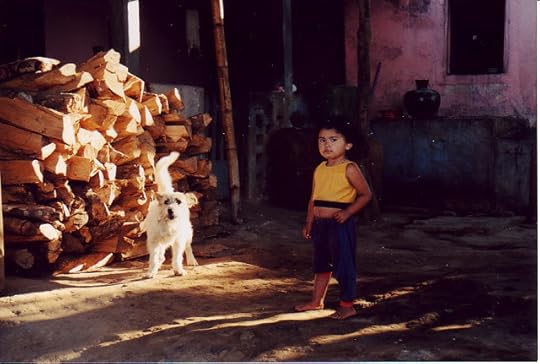
Yesterday in class, after teaching ourselves the memoir Drinking: A Love Story (Caroline Knapp), we allowed music to take us on a journey. Three different pieces—a touch of Cuba, a touch of tango, a touch of reggae. I wanted the students to find within the rhythms some memory of movement—of their own bodies taken across place and time. What is it to walk, to run, to drive, to jolt, to slide forward? How do we find the language that moves a passage ahead while at the same time unblurring the particulars of place, weather, mood? It was, in part, a lesson in verbs, or it might have been.
Later, coming home, I tried to remember my own journey language. How might I have attacked the assignment I gave to my own students? I recalled this passage from my third memoir Still Love in Strange Places. It is an odd thing to read your own work, years on. But this day at St. Anthony's farm, my husband's home, is still alive in me.
Wanting time to myself before I surrendered to the Spanish, I slid out of the tree and set off across the courtyard and out through the crooked, metal gate, calling to no one in particular that I wasn't going far. I went down the dirt road between the two dug-out walls of earth that towered above my head. Hiking up the road while I was hiking down came two brightly dressed women, their hair the color of ink, their postures accommodating the pitch of the road as well as the woven baskets in their arms and the plastic water jugs that sat on the yaguales upon their heads. One jug was blue and one was orange, and the women kept their eyes low as they passed, not meeting mine, not inviting inquiry, not keen, I sensed, on my camera.
I hadn't gone far before the dogs found me, an ugly, snarly pack, half starved and probably only partly sane, three or four, maybe, I can't remember. Mongrels. Their coats short, sparse, bristly as a wild pig's hide, their ears angered flat against their heads. They had nothing between them but their hunger, no reason not to attack the thin, white American girl-woman who had come among them accidentally and who now stood, grossly transfixed, as they blasphemed her through yellow teeth. I was aware of a broken tree limb on the road. I picked it up. I heeled my way up the incline, holding the stick out before me like some kind of Man of La Mancha warrior. I inched backward. Jowl to jowl, the dogs howled forward. I wondered if Bill would hear, if I'd be rescued, if I should turn and run like hell.
But before I could act, I was saved by a barefooted boy who out of nowhere appeared with a fistful of dog-deterring rocks. He hurled. The dogs scattered. The dogs returned. He hurled again. In the dissipating dust, I gestured my thanks, then half walked, half ran to the place I'd come from. I held the camera tight against my chest. I cursed the country, and I blessed it. I hurried past the gate of St. Anthony's, past a herd of wild chickens, past more women bearing jugs. I kept on walking until I came upon a path cut into the high wall of earth beside the road. The path rose vertically on tight, hard, dirt steps, and it was at the end of this path, as I'd been told, that the peasant dead were laid to rest. I swung my camera onto my back and pulled myself toward them with my hands.
To be among the dead at St. Anthony's is to enter into communion with wild turkeys....
For more thoughts on memoirs, memoir making, and prompt exercises, please visit my dedicated Handling the Truth page.




Published on February 27, 2013 02:50
February 26, 2013
don't let your lived life become a protracted mourning
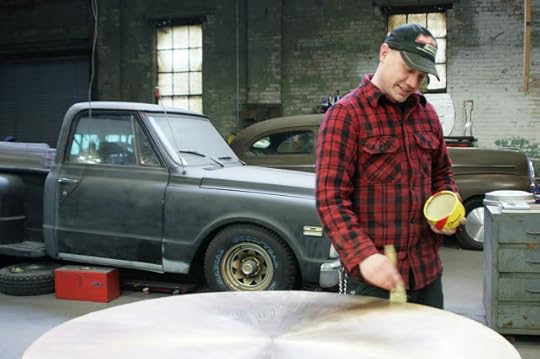
The other day, while waiting an hour or so down the road for a friend to arrive for a long-planned lunch date, I stole a few minutes with the February 25 issue of The New Yorker, which I had slipped into my oversized bag.
The magazine fell to page 77, Joan Acocella's story on Adam Phillips, called "This is Your Life." This first paragraph needs no Kephart intercessions. Just read it, and see if, on this day at least, it might save you. The photo above, by the way, is of Jeb Stuart Wood, whom I profiled in the Inquirer on Sunday. He's a foundry man at work here on a piece for the great sculptress Michele Oka Doner. Behind him are the old mobiles he restores when he finds time. Elsewhere are his own sculptures, suspended and waiting. I thought of Jeb often after my interview that day—of how broadly and peaceably he was living.
From The New Yorker:
Adam Phillips, Britain's foremost psychoanalytic writer, dislikes the modern notion that we should all be out there fulfilling our potential, and this is the subject of his new book, "Missing Out: In Praise of the Unlived Life (Farrar, Straus & Giroux). Instead of feeling that we should have a better life, he says, we should just live, as gratifyingly as possible, the life we have. Otherwise, we are setting ourselves up for bitterness. What makes us think we could have been a contender? Yet, in the dark of the night, we do think this, and grieve that it isn't possible. "And what was not possible all too easily becomes the story of our lives," Phillips writes. "Our lived lives might become a protracted mourning for, or an endless trauma about, the lives we were unable to live."




Published on February 26, 2013 07:08
February 25, 2013
The Philadelphia Literary Legacy Exhibition: happiness-inducing news

Earlier today I was writing to two special friends—Ruta Sepetys and A.S. King—and in both notes, for very different reasons, I was writing about how important it is to me to be seen as a Philadelphia writer. I love this city. I write about it whenever I can—in Philadelphia Inquirer stories, in novels (I'm at work on a Philadelphia/Florence-centric novel as we speak), in books like Flow. I've seen this city struggle, I've seen it emerge, I've walked it in sleet and in sun. I believe in it.
Imagine how amazed and delighted I was, therefore, to receive a note from Leah Douglas, who is the director of exhibitions at the Philadelphia International Airport. Her note read, in part, like this:
For 2013, I am organizing an exhibition that provides a visual overview of Philadelphia's rich literary past and present. Given the theme, I invited librarians from the Free Library of Philadelphia to create a list of 50 Philadelphia-area authors/poets/playwrights (either born in the Philadelphia region or who lived a portion of their lives in the Philadelphia area). And, hopefully you will be pleased to know that your name was included on the list.
Leah tells me that the exhibition will be launched on July 2
and live for a year in Terminal A. The unveiling
ceremony will be attended by Mayor Nutter, Airport CEO Mark Gale, and
President and Director of the Free Library Siobhan Reardon, among
others.
And yes, I'm going to be there.
The photo above was taken last Thursday evening, as I left the Penn campus. I had been working with a student for part of the afternoon and then attending an event with my father, a Penn alum. I was headed to the train, on the phone with my son, who is a city lover, too. "I hope you can see this night; the light is amazing," I was saying. I held the phone and I held my camera and I took this crooked shot.
But look at the light. That's how I feel.




Published on February 25, 2013 13:32
February 24, 2013
my story in today's Inquirer—Michele Oka Doner, Jeb Stuart Wood, Port Richmond
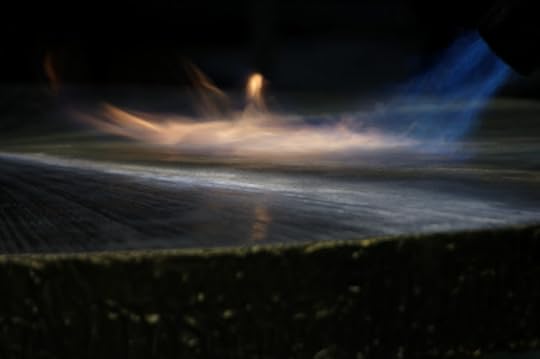
Yesterday I told the story of my first meeting with the internationally acclaimed artist Michele Oka Doner, and how that conversation became a friendship became a Philadelphia Inquirer story that celebrates artists in collaboration, the foundry master Jeb Stuart Wood, and the resurgent Port Richmond neighborhood.
Today I share the link.




Published on February 24, 2013 04:41
February 23, 2013
The Port Richmond story in the Inquirer: an artist at work with artists

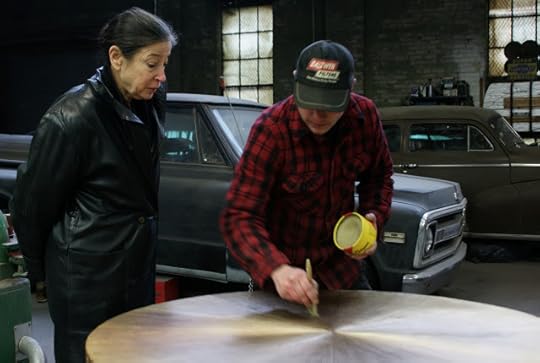
Weekends in the Inquirer are like Christmases of long ago—I wake even earlier than usual, and eager. My eagerness now is for the early edition of the Sunday news, where I've written of Chanticleer garden and the Jersey Shore, of ballroom dancing and Philadelphia light, of the Schuylkill River and the cemetery where I often go before I teach my class at Penn. This weekend my story features the internationally acclaimed artist Michele Oka Doner and a spectacular Port Richmond foundry owned by the artist Jeb Stuart Wood. It's a story about collaboration, trust, and a converted warehouse in former collier country.
I met Michele during National YoungArts week in Miami. I mentioned how much I liked the pin she was wearing. She said she'd made it, slipped me her card, mentioned the loft where she lives in New York City. When I told her that I hailed from Philadelphia she replied that she has much of her work cast there in a foundry she trusts—the sort of work that ends up in the Louvre and MOMA, the Hayden Planetarium and the Miami Airport, a Tiffany's in New York City or a store clear across the world, a private home. "Come visit us at work," she said, and a few weeks later I showed up at the door of Independent Casting.
From Jeb I learned about the resurgence of a part of Philadelphia I'd never traveled through. I learned about the art of casting, about what it takes to run a foundry and to work with some of the world's leading sculptors. From Michele I learned about art as conversation, about the bronzing of organic stuff, about rivers, history, mythology. I was out of my element, and I loved it.
Tomorrow I'll share the link to the whole story, which features a photograph of Michele at work in the foundry. Today I share the photos above and this first scanned page of story.
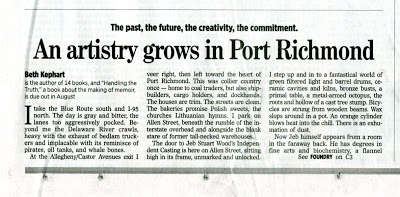




Published on February 23, 2013 06:43
February 22, 2013
early sensory memory: a memoir exercise
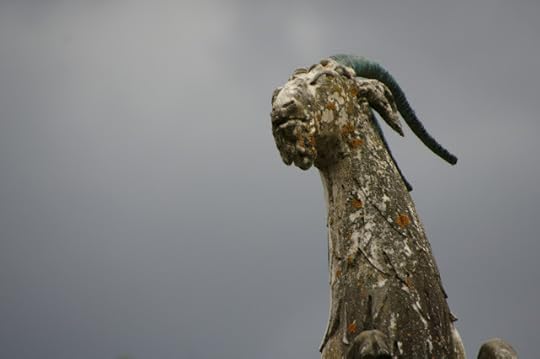
A few minutes ago, while searching for a slip of paper I had carried home with me from Florence, I found a folder full of exercises I'd given a private student years ago. We'd had a week together, eight hours each day, and I had given every day a name—Childhood Remembered, Place as Poetry, Beyond Life Itself, that sort of thing. The readings I'd assembled for each day were to serve as both inspiration and prompt.
Oh, I thought, as I rediscovered this folder. I should write a book about teaching, a book that would allow me to celebrate all the books I've loved. Or at least some of them. A fraction.
And then I remembered: I already did.
So here, for those of you seeking a prompt on this day, is a small simple thing. Return to your favorite passages in books (fiction or memoir, even poems—in this case it doesn't matter) that limn an early childhood scene. For my student I chose the early pages of Paul Horgan's The Richard Trilogy, A. Manette Ansay in Limbo, and Sue Monk Kidd from The Secret Life of Bees. We read the pages together and then considered:
* the physical details that surfaced most quickly when my student was asked to remember his childhood home;
* the nature of childhood memories that he considered most dear; and
* the first event in his life that he considered tragic.
He then wrote a fragment of memoir that returned to that time and place.
Here's a paragraph from Sue Monk Kidd to get you started:
At night I would lie in bed and watch the show, how bees squeezed through the cracks of my bedroom wall and flew circles around the room, making that propeller sound, a high-pitched zzzzz that hummed along my skin. I watched their wings shining like bits of chrome in the dark and felt longing build in my chest. The way those bees flew, not even looking for a flower, just flying for the feel of the wind, split my heart down its seam.
For more thoughts on memoirs, memoir making, and prompt exercises, please visit my dedicated Handling the Truth page.




Published on February 22, 2013 07:05
February 21, 2013
it was all too much (but not for my husband)

It doesn't matter why I told my students this bit of personal whatever on Tuesday, but when I said "I just started taking pottery lessons," they laughed.
Out loud.
It's probably because I don't have the natural grace of an artist, or the excellently good ideas, or maybe the time. But they laughed, one louder than the rest, and there I was, in the pottery studio this morning, wishing that I could laugh, too.
I only wanted to cry. We were to combine three techniques—the slab, the pinch pot, the coil—and make something wonderful. To my left—my artist husband, who has been designing three-dimensional things since the day he was born. To my right—my award-winning pottery teacher. In between—my clay and me.
Please understand that to get to the pottery studio I have to rise at four AM at least, get a half day's worth of corporate work in, write back to my beautiful memoir students, send a note to my fellowship student, read some of the books I've promised to read, start grading papers, exercise so I'm allowed to eat a cookie, set up the piles that will greet me upon my return. Oh, and wash my hair.
So I arrive at the studio out of breath. I arrive with all kinds of hopes for yoga calm. Breathe, I tell myself. Enjoy this. My husband at once begins his work on his already-signature slab columns that elicit all kinds of fabulous awe from the other women there. Bernadette, my instructor, is, of course, patiently building beautiful things. And I'm standing there with my pile of clay, trying to throw the air out of the slabs, roll the weight to an even thin, decorate decorously, slip and shine. (For you clay folk, I do know that the term is slip and score. At least I know the terms but, as a writer, I choose to bend them.)
My work was not working. My work became, as a reality TV show mother said famously last week, "a monstrosity of evil." Clay can be very kind, and clay can be very cruel. My clay was cruel to me.
I just kept thinking about all I should be doing at home. I just kept asking myself, Do I have to be good at this? Is this a requirement? Can I sleep under the table? Can I walk home? Somebody let me walk home.
But I stayed. I stayed until the end because Bernadette is too sweet to let me decide to leave and because my husband was having a ball. (Of course you're having a ball, I told him later. You're an artist! And you slept until seven! And you are not freaked out. You never freak out. Why can't you sometimes freak out? For in truth, my talented husband is also enviably calm.)
Here's the lesson that I learned today.
You can fail, and your life will go on.




Published on February 21, 2013 15:57
February 20, 2013
riding the train home from Penn

Last night, riding the train home in the wet muck of an undecided weather day, I, like an orchid bloom, held my secret close.
Today I share it with you.
I'm wholly love the students I teach. And they earn that love.




Published on February 20, 2013 10:38
February 19, 2013
in the aftermath of Work In Progress day, and remembering Gerald Cope

Yesterday, in response to a query from Ilie Ruby, I posted a few lines from a novel in progress and then invited all my Facebook writer friends to do the same. I wanted to shatter, for that one day at least, the loneliness that can stem from writing. I wanted to celebrate those who had published and those who will soon publish—to make it clear that we are all of the same yearning community, no barriers between us.
The response was enormous. Friends told friends told friends, and Facebook became a map of beginnings, a crest of awe, a wild fire net of encouragement and surprise.
Late in the day, my husband and I headed down to the city to take part in another act of essential community—the memorial service for Gerald M. Cope, the theatrical and compassionate leader of the architecture firm (Cope Linder Associates) where I worked as a new graduate of the University of Pennsylvania and where I met my husband before he left (within a handful of weeks) for graduate work at Yale. We would make enduring friendships at this place. Gerry, and his son Ian (who now leads the firm) would come to our wedding. My husband would return to work at the firm for many, many years more. Yesterday, at the Union League, we saw these old friends again for the first time in a decade, more.
Those who spoke at the memorial service—Gerry's children, his brother, his friend, his wife—brought Gerry back to tangible life, reanimating this glorious man who was committed to engendering joy. Gerry understood, one person said, that it wasn't what you said that would be remembered, or what you did. It was how you would make others feel. Gerry Cope had a way of making us all feel charming and charmingly important. He united us, and yesterday we were again all friends once more.




Published on February 19, 2013 06:40
February 18, 2013
Handling the Truth is featured in Library Journal's Nonfiction Previews

Gary Kramer, beloved publicist for my river book Flow: The Life and Times of Philadelphia's Schuylkill River (Temple University Press) as well as the forthcoming Dr. Radway's Sarsaparilla Resolvent, just sent word that Library Journal kindly featured Handling the Truth in its Nonfiction Previews for August 2013.
I am so happy to have this book of mine be placed among other true memoirs. I'm so grateful to Barbara Hoffert, who wrote:
Not a memoir proper, this book fits nicely with the others on this list
because it’s about writing memoir. Kephart has penned five.... She’s also mastered the
fiction and essay forms and currently teaches memoir writing at the
University of Pennsylvania, so she’s got the skills to explain every
facet of the writing process, including that crucial issue for
memoirists: where does imaginative shaping stop and disregard for truth
begin.
For more thoughts on memoirs, memoir making, and prompt exercises, please visit my dedicated Handling the Truth page.




Published on February 18, 2013 12:17



